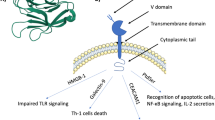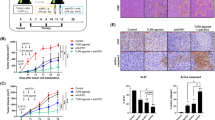Summary
Previous studies have shown that monoclonal antibodies (M.Ab) to the ganglioside GD3 may induce partial remissions in tumour growth in patients with melanoma. In vitro studies demonstrated that M.Abs to GD3 may also enhance lymphocyte responses to phytohemagglutinin and interleukin 2 (IL2). The present study extended these findings by showing that the IL2-dependent proliferative and cytotoxic response of T cell clones derived from a melanoma patient and a patient with the Vogt-Koyanagi-Harada syndrome were enhanced by pre-incubation of T cells with M.Ab to GD3. The degree of enhancement increased with the duration of pre-incubation from 2 to 24 h and applied to both T4+ and T8+ clones. The potentiation of these responses was not specific for M.Abs to GD3 but was also seen with M.Abs to GD2 and the T10 structure on T cells but not with M.Abs to the transferrin receptor or an isotype control M.Ab. Incubation of lymphocytes from a melanoma patient with M.Ab to GD3 during culture with autologous melanoma cells enhanced the proliferative response to the tumour. The expression of IL2 receptors (Tac epitope) on the T cells showed variable enhancement after incubation with M.Ab to GD3 but the significance of these findings in relation to the mechanism of the enhanced responses is not known. These results suggest that certain M.Abs may stimulate cell-mediated immune responses against tumour cells and that this may provide an additional mode of action of M.Abs against tumours in vivo
Similar content being viewed by others
References
Bolhuis RLH, Van De Griend RJ, Ronteltap CPM (1984) Clonal expansion of human B73.1-positive natural killer cells or large granular lymphocytes exerting strong antibody-dependent and independent cytotoxicity and occasionally lectin-dependent cytotoxicity. Nat Immun Cell Growth Regul 3:61
Cheresh DA, Harper JR, Schulz G, Reisfeld RA (1984) Localization of the gangliosides GD3 and GD2 in adhesion plaques and on the surface of human melanoma cells. Proc Natl Acad Sci USA 81:5767
Dippold WG, Knuth A, Meyer Zum Buschenfelde KH (1984) Inhibition of human melanoma cell growth in vitro by monoclonal anti-GD-ganglioside antibody. Cancer Res 44 (2):806
Dippold WG, Knuth A, Meyer Zum Buschenfelde KH (1984) Melanoma antibodies: Specificity and interaction with melanoma and cytotoxic T cells. Behring Inst Mitt No 74:14
Goodman GE, Beaumier P, Hellstrom I, Fernyhough B, Hellstrom KE (1985) Pilot trial of murine monoclonal antibodies in patients with advanced melanoma. J Clin Oncol 3:340
Grimm EA, Mazumder A, Zhang HZ, Rosenberg SA (1982) Lymphokine-activated killer cell phenomenon. Lysis of natural killer resistant fresh solid tumour cells by interleukin 2-activated autologous human peripheral blood lymphocytes. J Exp Med 155:1823
Grimm EA, Robb RJ, Roth JA, Weckers LM, Lachman LB, Wilson DJ, Rosenberg SA (1983) Lymphokine-activated killer cell phenomenon. III. Evidence that IL2 is sufficient for direct activation of peripheral blood lymphocytes into lymphokine-activated killer cells. J Exp Med 158:1356
Hersey P, Bindon C, Edwards A, Murray E, Phillips G, McCarthy W (1981) Induction of cytotoxic activity in human lymphocytes against autologous and allogeneic melanoma cells in vitro by culture with Interleukin 2. Int J Cancer 28:695
Hersey P, Schibeci SD, Townsend S, Burns C, Cheresh DA (1986) Potentiation of lymphocyte responses by monoclonal antibodies to the ganglioside GD3. Cancer Res 46 (Dec 1986)
Hersey P, MacDonald M, Schibeci S (1986) Clonal analysis of the nature and specificity of cytotoxic T cells in melanoma patients. In: Veronesi U, Cascinelli N, Santinami M (eds). Cutaneous Melanoma. Acad Press NY (in press)
Hersey P, MacDonald MJ, Schibeci SD, Burns C (1986) Cytotoxic T cell clones agianst autologous human melanoma cells. Classification based on phenotype specificity and inhibition by monoclonal antibodies. Cancer Immunol Immunother 22:15
Hoffman RA, Kung PC, Hansen WP, Goldstein G (1980) Simple and rapid measurement of human T lymphocytes and their subclasses in peripheral blood. Proc Natl Acad Sci USA 77:4914
Houghton AN, Mintz D, Cordon-Cardo C, Welt S, Fliegel B, Vadhan S, Carswell E, Melamed MR, Oettgen HF, Old LJ (1985) Mouse monoclonal IgG3 antibody detecting GD3 ganglioside: A phase I trial in patients with malignant melanoma. Proc Natl Acad Sci 82:1242
Itoh K, Tilden AB, Balch CM (1985) Role of interleukin 2 and a serum suppressive factor on the induction of activated killer cells cytotoxic for autologous human melanoma cells. Cancer Res 45:3173
Lotze MT, Strausser JL, Rosenberg SA (1980) In vitro growth of cytotoxic human lymphocytes. II. Use of T cell growth factor (TCGF) to clone human T cells. J Immunol 124:2972
Maelawa N, Yano A (1984) Two distinct cytotoxic T lymphocyte subpopulations in patients with Vogt-Koyanagi-Harada disease that recognize human melanoma cells. Microbiol Immunol 28:219
Oldham RK, Foon KA, Morgan AC, Woodhouse CS, Schroff RW, Abrams PG, Fer M, Schoenberger CS, Farrell M, Kumball E, Sherwin SA (1984) Monoclonal antibody therapy of malignant melanoma: In vivo localization in cutaneous metastasis after intravenous administration. J Clin Oncol 2:1235
Pope JH, Morrison L, Moss DJ, Parsons PG, Mary Sr R (1979) Human malignant melanoma cell lines. Pathology 11:191
Pukel CS, Lloyd KO, Travassos LR, Dippold WG, Oettgen HF, Old LJ (1982) GD3 a prominent ganglioside of human melanoma. J Exp Med 155:1133
Rabin H, Hopkins RF, Ruscetti FW, Neubauer RH, Brown RL, Kawakami TG (1981) Spontaneous release of a factor with properties of T cell growth factor from a continuous line of primate tumor T cells. J Immunol 127:1852
Reinherz EL, Schlossman SF (1981) The characterization and function of human immunoregulatory T lymphocyte subsets. Immunol Today 2:69
Suzuki R, Handa K, Itoh K, Kumagai K (1983) Natural killer cells as a responder to interleukin 2 (IL2). Proliferative response and establishment of cloned cells. J Immunol 130:981
Uchiyama T, Broder S, Waldmann TA (1981) A monoclonal antibody (anti-Tac) reactive with activated and functionally mature human T cells. J Immunol 126:1393
Van De Griend RJ, Van Krimpen BA, Bol SJL, Thompson A, Bolhuis RLH (1984) Rapid expansion of human cytotoxic T cell clones: Growth promotion by a heat labile serum component and by various types of feeder cells. J Immunol Methods 66(2):285
Vose BM, Bonnard GD (1982) Specific cytotoxicity against autologous tumour and proliferative responses of human lymphocytes grown in Interleukin 2. Int J Cancer 29:33
Author information
Authors and Affiliations
Rights and permissions
About this article
Cite this article
Hersey, P., MacDonald, M., Burns, C. et al. Enhancement of cytotoxic and proliferative responses of lymphocytes from melanoma patients by incubation with monoclonal antibodies against ganglioside GD3 . Cancer Immunol Immunother 24, 144–150 (1987). https://doi.org/10.1007/BF00205592
Received:
Accepted:
Issue Date:
DOI: https://doi.org/10.1007/BF00205592




